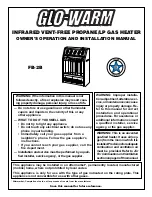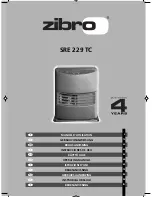
7
FACTS TO CONSIDER ABOUT THE LOCATION
Carefully choose an indoor location for the new water heater, because
the placement is a very important consideration for the safety of the
occupants in the building and for the most economical use of the
appliance.
This water heater is not for use in manufactured
(mobile) homes or outdoor installation.
Whether replacing an old water heater or putting the water heater in a
new location, the following critical points must be observed:
1. The location selected should be indoors, as close as practical to the
outside wall through which the water heater vent is going to be
installed, and as centralized with the water piping system as possible.
The water heater, as all water heaters, will eventually leak. Do not
install without adequate drainage provisions where water flow will
cause damage.
2. Selected location must provide adequate clearances for servicing
and proper operation of the water heater.
Installation of the water heater must be accomplished in such a manner
that if the tank or any connections should leak, the flow will not cause
damage to the structure. For this reason, it is not advisable to install the
water heater in an attic or upper floor. When such locations cannot be
avoided, a suitable drain pan should be installed under the water heater.
Drain pans are available at your local hardware store. Such a drain
pan must have a minimum length and width of at least 2 inches (5.1 cm)
greater that the water heater dimensions and must be piped to an
adequate drain. Drain pan depth must allow for access to the outer
doors for servicing the pilot and burner.
Water heater life depends upon water quality, water pressure and
the environment in which the water heater is installed. Water heaters
are sometimes installed in locations where leakage may result in
property damage, even with the use of a drain pan piped to a drain.
However, unanticipated damage can be reduced or prevented by a
leak detector or water shut-off device used in conjunction with a
piped drain pan. These devices are available from some plumbing
supply wholesalers and retailers, and detect and react to leakage in
various ways:
• Sensors mounted in the drain pan that trigger an alarm or turn off the
incoming water to the water heater when leakage is detected.
• Sensors mounted in the drain pan that turn off the water supply to
the entire home when water is detected in the drain pan.
• Water supply shut-off devices that activate based on the water
pressure differential between the cold water and hot water pipes
connected to the water heater.
• Devices that will turn off the gas supply to a gas water heater while
at the same time shutting off its water supply.
LOCATING THE NEW WATER HEATER
INSTALLATIONS IN AREAS WHERE FLAMMABLE LIQUIDS (VAPORS)
ARE LIKELY TO BE PRESENT OR STORED (GARAGES, STORAGE AND
UTILITY AREAS, ETC.): Flammable liquids (such as gasoline, solvents,
propane [LP or butane, etc.] and other substances such as adhesives,
etc.) emit flammable vapors which can be ignited by a gas water heater’s
pilot light or main burner. The resulting flashback and fire can cause
death or serious burns to anyone in the area, as well as property damage.
If installation in such areas is your only option, then the installation must
be accomplished in a way that the pilot flame and main burner flame are
elevated from the floor at least 18 inches (45.7 cm). While this may
reduce the chances of flammable vapors, from a floor spill being ignited,
gasoline and other flammable substances should never be stored or
used in the same room or area containing a gas water heater or other
open flame or spark producing appliance. NOTE: Flammable vapors may
be drawn by air currents from other areas of the structure to the appliance.
Содержание Green Choice
Страница 3: ...3 GENERALSAFETY ...
Страница 30: ...30 ...
Страница 36: ...36 REPAIR PARTS LIST ...
Страница 38: ...38 REPAIR PARTS LIST ...
Страница 41: ...41 NOTES ...
Страница 42: ...42 NOTES ...
Страница 43: ...43 NOTES ...
Страница 44: ...44 ...








































